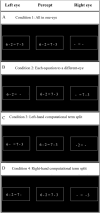Ancient visual channels have a causal role in arithmetic calculations
- PMID: 34815496
- PMCID: PMC8610989
- DOI: 10.1038/s41598-021-02260-9
Ancient visual channels have a causal role in arithmetic calculations
Abstract
Humans exhibit complex arithmetic skills, often attributed to our exceptionally large neocortex. However, the past decade has provided ample evidence that the functional domain of the subcortex extends well beyond basic functions. Using a sensitive behavioral method, for the first time, we explored the contributions of lower-order visual monocular channels to symbolic arithmetic operations, addition and subtraction. The pattern of results from 4 different experiments provides converging evidence for a causal relation between mental arithmetic and primitive subcortical regions. The results have major implications for our understanding of the neuroevolutionary development of general numerical abilities-subcortical regions, which are shared across different species, are essential to complex numerical operations. In a bigger conceptual framework, these findings and others call for a shift from the modal view of the exclusive role of the neocortex in high-level cognition to a view that emphasizes the interplay between subcortical and cortical brain networks.
© 2021. The Author(s).
Conflict of interest statement
The authors declare no competing interests.
Figures







References
-
- Grabner RH, et al. To retrieve or to calculate? Left angular gyrus mediates the retrieval of arithmetic facts during problem solving. Neuropsychologia. 2009;47:604–608. - PubMed
-
- Dehaene S, Cohen L. Cerebral pathways for calculation: Double dissociation between rote verbal and quantitative knowledge of arithmetic. Cortex. 1997;33:219–250. - PubMed
-
- Dehaene S, Piazza M, Pinel P, Cohen L. Three parietal circuits for number processing. Cogn. Neuropsychol. 2003;20:487–506. - PubMed
-
- Dehaene S, Molko N, Cohen L, Wilson AJ. Arithmetic and the brain. Curr. Opin. Neurobiol. 2004;14:218–224. - PubMed
-
- Andres M, Pelgrims B, Michaux N, Olivier E, Pesenti M. Role of distinct parietal areas in arithmetic: An fMRI-guided TMS study. Neuroimage. 2011;54:3048–3056. - PubMed
Publication types
MeSH terms
Grants and funding
LinkOut - more resources
Full Text Sources
Miscellaneous

